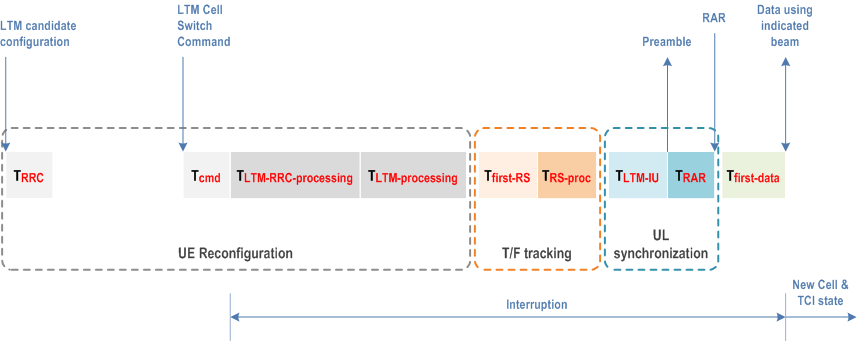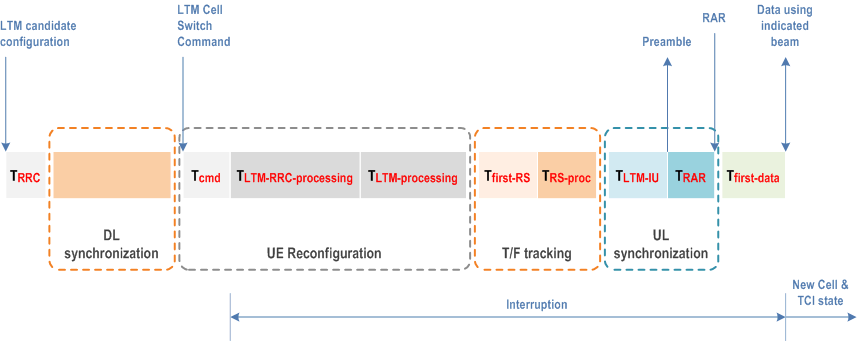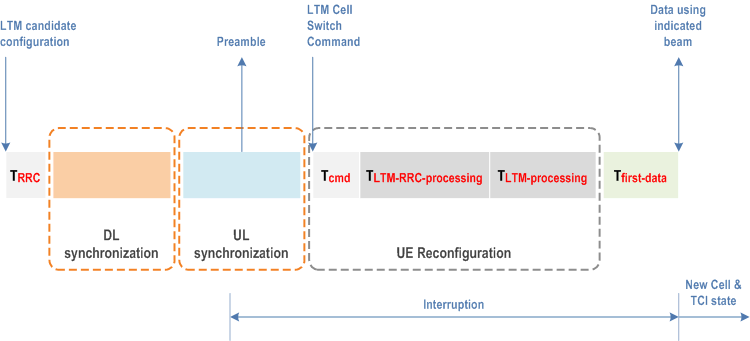Content for TS 38.300 Word version: 18.2.0
1…
4…
4.7…
5…
5.3…
5.4…
6…
6.2…
6.6…
7…
8…
9…
9.2.2…
9.2.2.5…
9.2.3…
9.2.3.2…
9.2.3.3…
9.2.4…
9.2.6…
9.3…
10…
11…
15…
15.5…
16…
16.2…
16.3…
16.4…
16.8…
16.9…
16.10…
16.12…
16.12.5…
16.12.6…
16.12.6.3
16.12.7
16.13…
16.14…
16.15…
16.18…
16.19…
16.21…
16.21.3…
17…
18…
19
20…
21…
A…
B…
C…
G…
G Components of Mobility Latency |R18| p. 259
Mobility interruption time for L1/L2 Triggered Mobility (LTM) is the time from UE receives the cell switch command to UE performs the first DL/UL reception/transmission on the indicated beam of the target cell.
The latency of the mobility procedure for LTM is characterized by the terms illustrated in Figure G-1.

Each component of mobility latency is described in the table below, the values of which are specified in clause 6.3 of TS 38.133. The value of TRRC is specified in clause 12 of TS 38.331.
| Component | Meaning |
|---|---|
| TRRC | Processing time for RRCReconfiguration carrying candidate configurations |
| Tcmd | Time for processing L1/L2-command (HARQ and parsing) |
| TLTM-RRC-processing | Early ASN.1 decoding and validity/compliance check |
| TLTM-Processing | UE processing including applying target cell parameters and L1/L2 changes |
| Tfirst-RS | Time for fine tracking and acquiring full timing information |
| TRS-proc | Time for SSB processing |
| TLTM IU | Interruption uncertainty in acquiring the first UL transmission |
| TRAR | Time for RAR delay |
| Tfirst-data | Time for UE performs the first DL/UL reception/ transmission on the indicated beam of the target cell, after RAR |
The latency of the RACH-based and RACH-less LTM procedure is characterized by the terms illustrated in Figure G-2 and Figure G-3. In particular, Figure G-2 shows the LTM procedure where UE activates a TCI state of an LTM candidate cell before performing an LTM cell switch which involves a random access procedure. Further, Figure G-3 shows the LTM procedure when the UE performs the UL and DL synchronization before performing an LTM cell switch which does not involve any random access. In both figures, it is highlighted how the overall mobility latency of LTM can be reduced by early synchronization procedure. Further details on the UE processing timer of the delay components are specified in clause 6.3 of TS 38.133.

